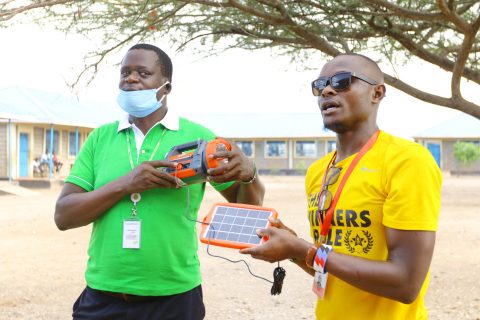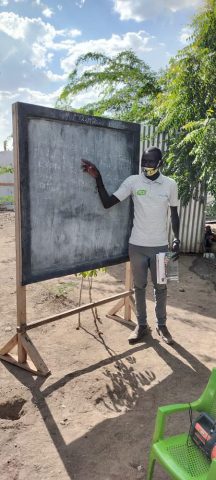World Teachers’ Day celebrates teachers in crises: “When learners cannot come to school, we have to go to them”
World Teachers’ Day on October 5 celebrates teachers in crises. The Covid-19 pandemic has significantly added to the challenges of teachers to protect people’s right to education but teachers like 27-year-old Obang Omot Oboya ensure no one is left behind during school closures.
Mr Oboya teaches mathematics and science in Kakuma refugee camp in Kenya. Below, he explains how teachers stepped up to the challenge.
“The year 2020 brought along with it perhaps one of the biggest challenges that the world’s teachers have faced. Kenya is not an exception. Even teachers with decades of experience have had to learn something new: how do we support learners when they cannot come to school?

Finn Church Aid distributing solar-powered radios in Kakuma refugee camp.
Following the school closures, teaching in Kenya moved to radio broadcasts and virtual platforms. The first step for us was ensuring that learners in Kakuma refugee camp had access to the national broadcasts. FCA distributed radios to the families, and we worked together with agencies in finding new solutions to complement the radio lessons with recaps and homework.
Schools have assigned each teacher in Kakuma a cluster of groups with six learners per group. Six learners share one radio. The arrangement adheres to the social distancing guidelines of Kenya’s Ministry of Health as the FCA supported teachers accompany each group separately.
At the end of every lesson, the radio teacher usually gives assignments. We mark their homework, and this makes radio lessons more authentic.
As long as learners cannot come to school, we have to go to them.
Mathematical formulas need to be visualised

Mr Oboya visualises radio lessons on a blackboard.
The first days were challenging for both teachers and learners. As teachers, we are in the habit of being personally in touch with learners in the classroom, be it just going around and seeing what they are doing. This is not possible for the radio teacher. And for my part, my current role does not include, for instance, planning lessons. We rely on what the radio teacher prepares.
In the beginning, it was difficult to catch the interest of learners through the radio and get them into a radio class routine. We also had to help learners with tuning in to the right frequency.
To enable learners to be attentive during the radio lesson, I usually come with a blackboard and chalk for the purpose of demonstration. The learners have to see the mathematical formulas while they follow the radio lessons on math. This helps learners to be attentive.
I also break down lessons into segments and achievable goals, and I attend to each student individually to ensure that they grasp the concepts. By now, everyone has got the hang of it.
A fruitful collaboration between teachers and parents
The new ways of learning have also provided relief to both teachers and learners, compared to our usual setting. I can now attend to each learner’s needs differently compared to a classroom. It is easier to listen to a group of six learners at the time than to the 80 learners I used to teach in a classroom. Teachers can quickly identify and support, for instance, slow learners.
I now teach 48 learners per day, divided into eight groups. There are eight radio lesson per day, 35 minutes each, which means I give one lecture per group. The remaining 32 learners from my class are taught by parents who volunteer as teachers after training with FCA.
What has been most important is that the parents are also involved in their children’s learning process. We collaborate more with parents since they join us in accompanying the pupils during the radio lessons and ensure that their children do their assignments. Parents and teachers collaborate in motivating the children and monitoring that they do their homework.
We also collaborate more with the parents on WhatsApp for the children’s learning, for instance, by recording learning materials on our phones and sharing them with parents in WhatsApp groups that we have established. The learners have to use their parents’ devices.
Girls at risk during distance learning
There is, unfortunately, one function that the distance learning arrangements cannot fully address: schools typically constitute a safe space for children and youth, particularly girls.
When girls are in school, they are less likely to become victims of sexual abuse or be forced into marriage. During this pandemic, the school buildings cannot protect the girls.
Some of the learners I used to teach have become pregnant during the time schools have been closed. We conclude that our homes and camps are not safe when the children are idle.
The affected girls need psychosocial support and assistance in continuing with their education.
Teaching is a call and a passion. The best World Teachers’ Day gift I can give my learners in this year of the pandemic is my time and spirit of adapting to the distance learning.
I hope that my pupils will not let this episode blindly, that they will be more resilient and take the new norms as a way of life and achieve their goals.”
Teacher Obang Omot Oboya was interviewed by FCA Kenya’s Communications Intern Elizabeth Oriedi. FCA works with education in Kakuma refugee camp together with Unicef and UNHCR.